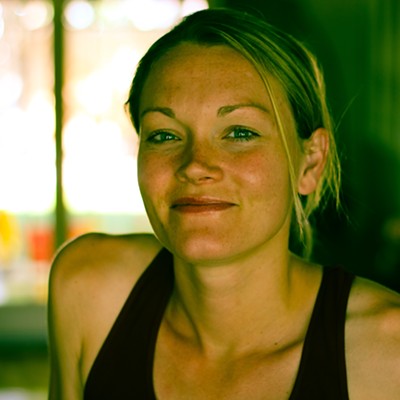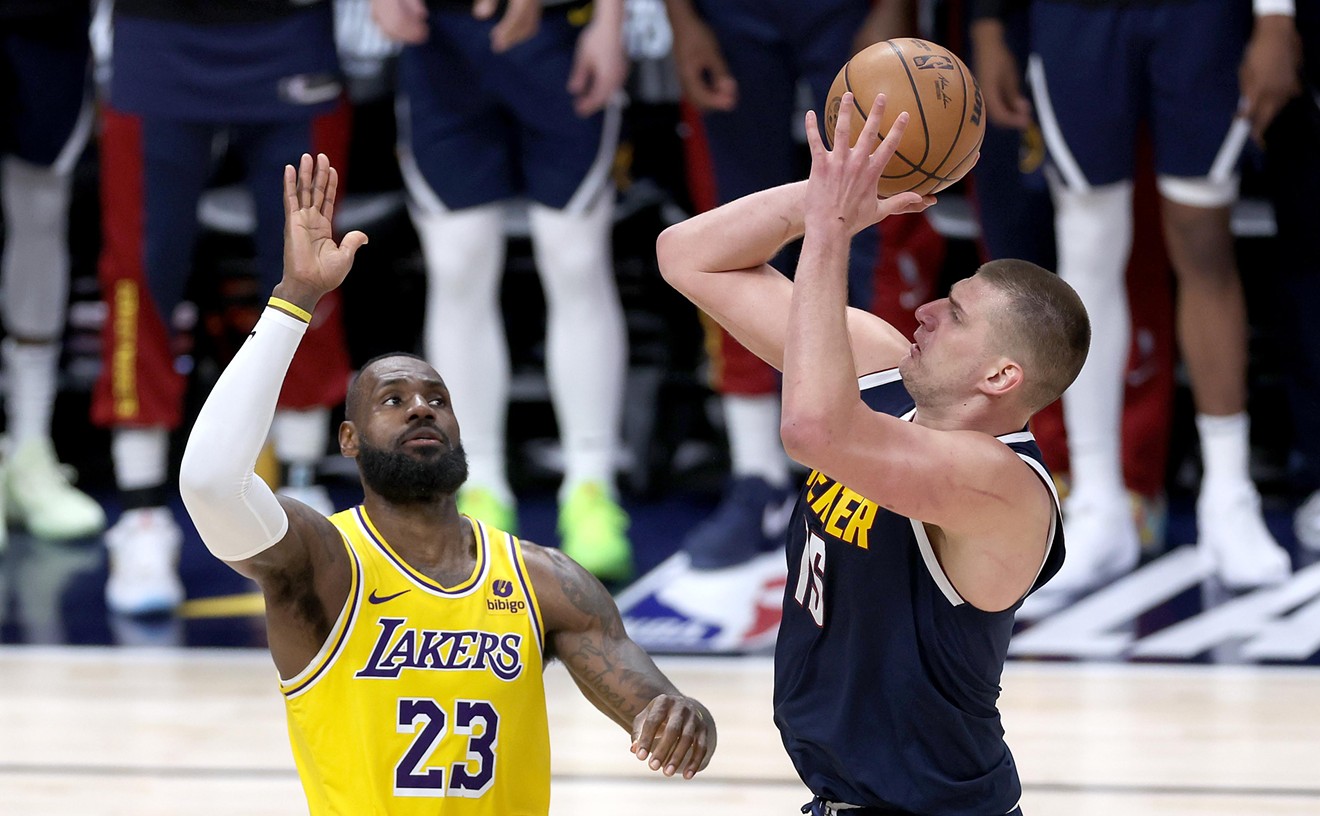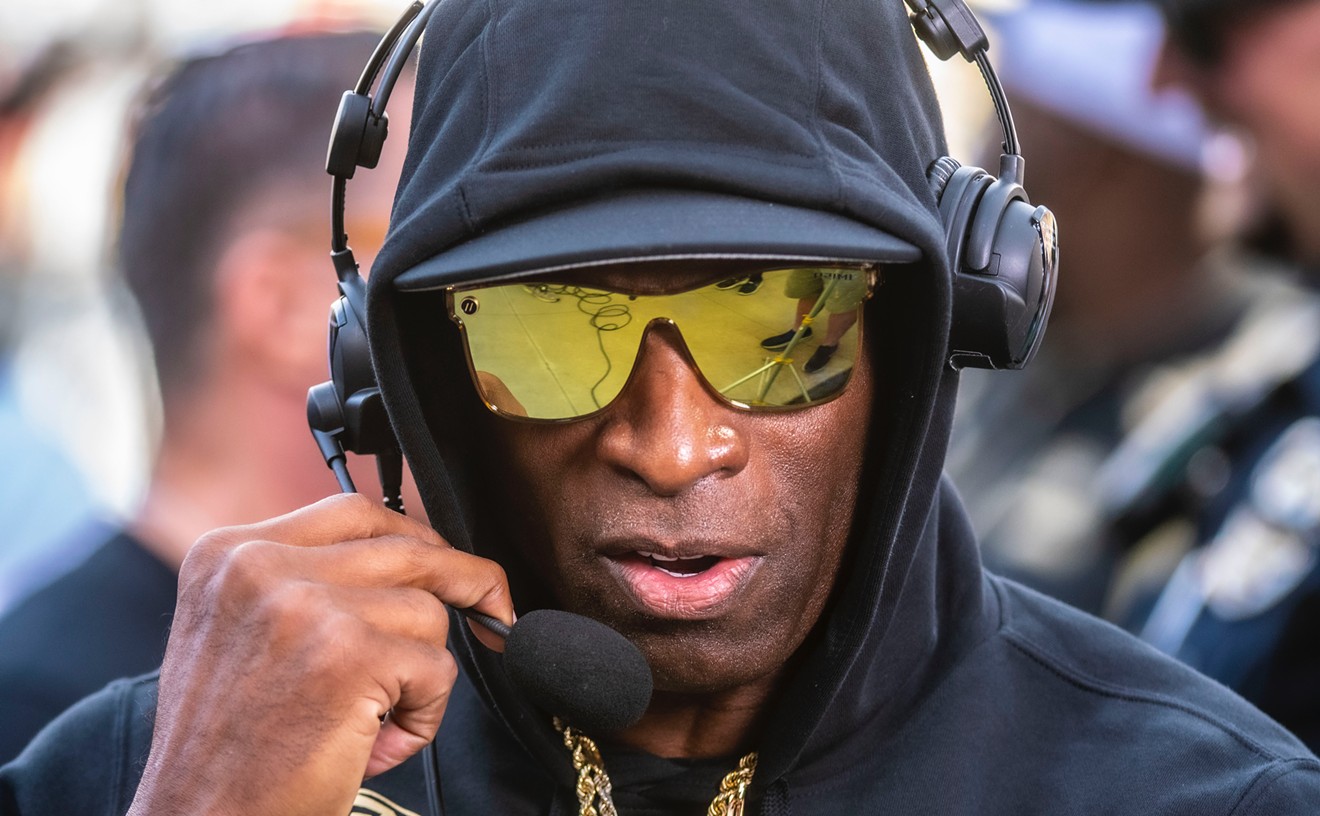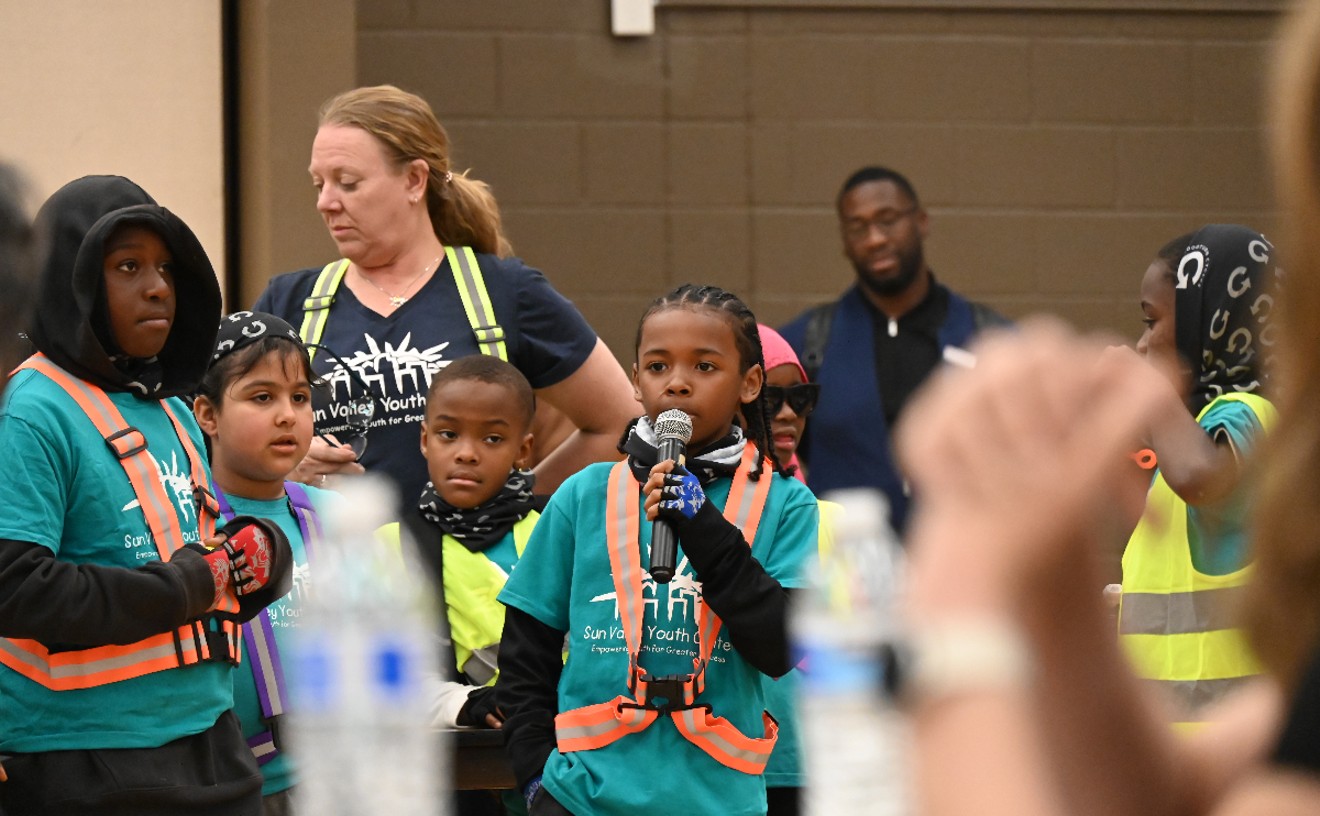Diaz-Rivera is wrapping up his first year teaching language arts and literacy at Columbine Elementary School, located in the Skyland neighborhood north of City Park. On this day — like most days — Diaz-Rivera is dressed to impress. “I try to dress professionally to combat against the stereotypes my students have learned about minorities and professionalism,” he explains.
Business attire aside, the classroom vibe is relaxed, and Diaz-Rivera isn’t afraid to crack a joke or two mid-lecture to keep his audience engaged while talking about writing opinion letters to newspapers, the topic at hand.
As the only black male teacher at Columbine Elementary, Diaz-Rivera brings something unique to his school. Technically, he says, “I’m Afro-Latinx,” — a gender-neutral term for Latino — “but I guess I look like a black guy.” In fact, most of Diaz-Rivera’s students didn’t realize he was Latino until they saw his last name.
Diaz-Rivera grew up in Colorado Springs with his mom, a Latina, and his half-siblings. His father is African-American, but Diaz-Rivera didn’t learn much about his black heritage from his dad because the ex-Marine was absent for most of his son’s childhood. Despite this personal history, Diaz-Rivera says, “it’s been a little easier connecting with black students. But,” he adds, “I think my connections with the Latinx students work once I note our similarities.”
And that’s sort of the point. Diaz-Rivera was hired by Denver Public Schools in 2016 as part of Make Your Mark, a partnership of DPS, some charter schools and the city that aims to bring diverse teachers to local schools.
The theory — backed by research — is that diverse teachers can better serve diverse students, and the goal of the program is to start closing the achievement gap by addressing a district-wide diversity-hiring gap. Three-quarters of DPS’s 92,000 students are students of color. The majority — about 55 percent — are Hispanic, and another 13.4 percent are African-American.
“I think my connections with the Latino students work once I note our similarities.”
tweet this
“We have a very diverse student population,” notes Katie Clymer, director of talent acquisition for DPS and the district’s liaison on Make Your Mark. The problem is that fewer than half of DPS’s African-American and Hispanic students are performing proficiently. This gap in academic achievement isn’t the only inconsistency that school officials are tracking.
DPS, the fastest-growing urban school district in the U.S., has struggled to hire and retain educators as racially and ethnically diverse as its students. A mere 25 percent of the district’s teachers are educators of color, which might play into the academic disparities that exist between white students and students of color.
And a report released last year and commissioned by Denver Public Schools revealed that black teachers felt isolated and felt as though their ideas weren’t valued. They feel “under attack” and believe that seasoned teachers of color are regularly pushed out of schools. DPS formed a task force to come up with ways to address the findings of the report; the group’s recommendations will go before the Denver Board of Education in June.
“Educators of color seem to do a good job at making a dent in the achievement gap,” Diaz-Rivera says. His theory is corroborated by academic research. Having at least one black teacher in the third through fifth grades reduced a black student’s probability of dropping out of school by 29 percent, according to a new study from researchers at American University, Johns Hopkins University and the University of California, Davis. For very low-income black boys, the results are even more pronounced, as their chance of dropping out plummeted by 39 percent.
This phenomenon is called “the role model effect,” and the term gets at why one school year with a black teacher can be so beneficial for black students. In Diaz-Rivera’s experience, the role model effect allows “minority teachers to build relationships with minority students fast because of a surface-level connection.”
Anecdotally, the theory has panned out in his classroom this year. The majority of Diaz-Rivera’s forty students (he has twenty per class) are black and Hispanic, and their diversity echoes that of the entire elementary school, where 90.8 percent of the 262 students are students of color. Of those 90.8 percent, 112 students are Hispanic, 112 are black, and a handful are biracial, American Indian and Asian/Pacific Islander. Nearly 90 percent of the children at Columbine Elementary are on free or reduced lunch, indicating a high level of poverty.
Columbine has done well with regard to attracting educators of color: Nearly half of the school’s early-childhood through fifth-grade teachers are minorities.
But Diaz-Rivera’s path to Columbine and Make Your Mark wasn’t easy. “I haven’t always been the outstanding citizen that I am today,” he admits. “After high school, I made some mistakes. I got into some trouble trying to find my way in the world.”

When Antonio Parés taught in predominantly Hispanic south Texas, he used his background to connect with his students.
Anthony Camera
There was marijuana in the trunk. “If I remember correctly, it was less than two ounces,” Diaz-Rivera says. Because the marijuana was packaged in multiple containers, Diaz-Rivera was charged with a Class 5 felony. In order to lower his jail sentence and avoid a trial, he accepted a plea bargain, confessing instead to a Class 6 felony.
In addition to being slapped with a hefty fine, Diaz-Rivera was sentenced to three years at the Criminal Justice Center, a county jail in Colorado Springs. As a nonviolent, first-time offender, he was eligible to participate in the El Paso County Sheriff’s Office’s Work Release Program, and served four months of his sentence at the Metro Work Release Facility before being released early on probation.
During his four months at the Metro Work Release Facility, Diaz-Rivera explains, “I was able to leave to go to work for eight hours a day, but had to be at the jail at all other times.” Diaz-Rivera paid his fines and got out on good behavior — but he’d still have plenty of uphill battles to fight. “It took me years to overcome that felony marijuana charge,” he says.
After serving his time, Diaz-Rivera struggled to find an employer that was willing to hire — and keep — a felon. He was hired for a job at a call center but was fired a week into his training when the company’s human-resources department began processing his paperwork. “That has actually happened a few times — starting jobs and being shut down after the paperwork was processed,” Diaz-Rivera says, adding, “It was frustrating.”
“I dealt with some real depression,” he continues. Growing up, he’d been placed in gifted-and-talented programs in school, and he had always considered himself an intellectual. “I had dreams and hopes,” Diaz-Rivera says.
“That first night in jail, I’ll never forget sitting up in my bed, thinking about all of the doors that had closed up for me. It was hard coming to the realization that one of my only real options for work was going to be in fast food.”
Then, in 2007, Diaz-Rivera got a job at a family fun center, of all places. What Diaz-Rivera assumed would be a lame gig ended up changing the trajectory of his life. “I realized I had a knack for working with kids,” he says.
With that epiphany and some guidance from a parole officer, Diaz-Rivera enrolled at Pikes Peak Community College in 2008. After earning an associate’s degree in psychology, he applied to Metropolitan State College of Denver, where he graduated with a bachelor’s degree in art therapy for at-risk youth.
Diaz-Rivera was hoping to work with children. But, he says, “I was getting shut down left and right. With a felony conviction, a lot of people aren’t going to let you work with kids.”
He went into mentoring instead, volunteering first with Colorado Youth at Risk, and later accepting a paid position with Friends for Youth. Two years into mentoring, one thing was clear: “A lot of my kids were already caught up in the system,” Diaz-Rivera explains. “My thought was that I needed to be more proactive, to reach students at a younger age.”
He applied for a teaching fellowship at University Prep, a charter school in Denver that participates in Make Your Mark. Right away, Diaz-Rivera knew he’d found his calling. “Relationship-building is one of my strengths,” he says. “I’m able to get to a level with students that a lot of other teachers aren’t able to reach.”
University Prep wasn’t a good fit for Diaz-Rivera for a long-term career. But another program, Make Your Mark — being offered through Denver Public Schools — was. “It took me a lot of years of community service and volunteering to get to where I am today,” Diaz-Rivera says. “I’m finally at a point where I’m feeling successful, and I’m so grateful that Make Your Mark was there to get me in the door.”
Make Your Mark got nearly two dozen teachers of color “in the door” for the 2016-2017 school year. That’s not a huge number — the district typically hires hundreds of teachers annually — but it’s a start.
“Recruiting highly effective teachers who are racially and ethnically diverse is a critical investment in our community,” says Mayor Michael Hancock, who has been a strong supporter of Make Your Mark since its inception in 2015. “If we’re going to build a world-class education system for the kids of Denver, we must have teachers who can help build learning experiences that are culturally responsive.”
“We want more high-performing seats across the district, and more quality schools,” says Erin Brown, executive director of the Office of Children’s Affairs for the City of Denver, which is why the city has teamed up with DPS on Make Your Mark.
Make Your Mark could best be described as a collective. “It’s a standalone entity that is not housed in the city or in the district — though both provide guidance and shape,” Brown explains. Organizations such as the Donnell-Kay Foundation, the Walton Family Foundation, the Carson J. Spencer Foundation and the Rose Community Foundation are involved, too, along with eight charter schools: University Prep, Rocky Mountain Prep, KIPP: Colorado, Strive Preparatory Schools, DSST, Roots Elementary, Girls Athletic Leadership School, and the Boys School of Denver. When it comes to its hiring efforts, Make Your Mark funnels qualified applicants into both DPS and charter schools.
“One thing that makes [Make Your Mark] so unique is the collaboration that’s happening between the district and charter schools,” Brown says. “That really takes people aback.”
Unlike a traditional school, a charter operates under its own governance and doesn’t report to the district. It isn’t typical for district and charter schools to partner — especially on recruitment, given the inherent competition in hiring. But in Denver, Brown says, “we are banding together and pooling our resources to address a problem that impacts all of us.”“We want more high-performing seats across the district, and more quality schools.”
tweet this
Participating entities pay into Make Your Mark, contributing funds based on their size. DPS, for example, committed $7,500 dollars this year toward Make Your Mark’s total operating budget of $200,000. The city is a major fiscal agent for the program, and the expense is absolutely worth it, Brown says, pointing to a growing body of research indicating that diverse teachers are extremely valuable to students of color.
“The statistics are just mind-blowing, and they add a lot of context to this whole thing,” says Antonio Parés, a partner at the Donnell-Kay Foundation, a Denver-based think tank that aids in funding Make Your Mark.
Parés, a Latino, says, “I never had a Latinx teacher in my entire educational career.” In fact, the only Latinx employees Parés remembers seeing on his school campuses were janitors and food-service providers. “This can create a distorted view of what you, as a young Latinx, might think is possible for yourself in regard to education,” he adds.
After graduating from the University of Colorado Boulder, the Colorado native moved to Texas for a two-year stint with Teach for America, which had him schooling sixth- and seventh-graders in topics such as government and history. “I taught in south Texas, along the border of Mexico,” says Parés. “About 90 percent of the students in my classroom also identified as Latino or Hispanic.”
Parés had read something interesting before relocating to Texas. Shared experiences, he’d discovered, can help teachers create stronger relationships with their students. “I knew that was important,” Parés says. Both of his parents are teachers, and they’d instilled in their son the notion that teaching is “largely relational,” as he puts it.
Parés recounts his first day of teaching in Texas: “When I spelled my name on the board, I threw the accent mark over the e, and all of the students lit up,” he says. “That last name went a long way in developing the culture in my classroom.”

Make Your Mark managing consultant Makisha Boothe amped up its social-media strategy to recruit more educators of color.
Don Sawyer Photography
“People outside of Colorado don’t necessarily think of Denver as a community with a large population of individuals of color,” Parés says. “You don’t always hear about the rich history of Five Points and the jazz renaissance, or the American Chicano movement in the 1960s and 1970s that was, in part, led by students from North High School. And that’s the very reason we launched Make Your Mark.”
The collective started with the lofty goal of “increasing the diversity of teachers in Denver,” DPS’s Clymer says. “Recognizing that our local universities are not graduating enough educators of color, we decided to go outside of Colorado to recruit.”
“DPS really knew the value of diversity and wanted to do something bigger than it had done in the past,” says Parés. And by November of 2015, Make Your Mark had enough money to launch — just in time for teacher-recruitment season.
In its pilot year, the program focused its resources on building a brand that showcased Denver as a place where people of color can have rich, full lives. It sent advocates to recruit at national events such as the Alumni of Color Conference at Harvard. “We tried to capitalize off of existing national efforts instead of creating our own,” Brown says.
Make Your Mark also piggybacked off DPS’s annual diversity hiring fair in the spring of 2016 — the DPS Teach in Denver Mile High Showcase — and the collective funded two weekend-long conferences created to court the district’s top out-of-town candidates. Thirty recruits were brought into Denver for trips packed with conferences and events, and 22 of those candidates — Diaz-Rivera included — accepted positions with the district. Of the 22 teachers of color DPS hired last year with Make Your Mark’s help, seven were in-state applicants; the remaining fifteen were recruits from other states.
During Make Your Mark’s inaugural year, Brown explains, the collective began looking at developing networks in other cities. “But it just didn’t come to fruition,” Brown says, adding, “We had a really strong brand, but we needed to make our marketing strategy more deliberate.”
Makisha Boothe, a former DPS employee, was brought on as managing consultant for Make Your Mark in early 2017. Her main contribution to the collective has been an amped-up digital marketing campaign targeted at five cities with diverse populations: Chicago; Atlanta; San Juan, Puerto Rico; and Pueblo and Colorado Springs.
In addition to ensuring that Make Your Mark had a daily presence on Facebook and Twitter, Boothe placed content on YouTube and launched an e-mail marketing campaign containing pertinent information for educators of color who might be interested in relocating to Denver. She also started up a blog and is preparing to release a new webinar series consisting of “mini-orientations” designed to familiarize non-Denverites with the city.
Boothe employed grassroots marketing efforts, as well. “We didn’t have the resources to go to all of the cities we targeted,” she explains. In Puerto Rico, for example, Make Your Mark engaged a street team of ten San Juan residents to recruit for the collective on college campuses there.“DPS really knew the value of diversity and wanted to do something bigger than it had done in the past.”
tweet this
Boothe, Brown and Hancock went to Chicago earlier this year to recruit and do “a lot of myth-busting,” Boothe says. “People don’t expect that we have an African-American mayor. We shared stories about our African-American and Latino leaders and answered questions for people of color.” Questions like, are there salons there for me? Are there churches and spiritual communities I can be a part of? “By answering those questions,” Boothe continues, “we can show out-of-towners that Denver is a place for all people.”
The new marketing strategy is working. During its pilot recruiting season, Make Your Mark received a few dozen applications. Within two months of relaunching its website this year, the program received inquiries from over 400 potential candidates. About 300 of those folks submitted résumés, and Make Your Mark aims to bring in at least thirty teachers of color for the 2017-2018 school year. The collective is currently discerning the most efficient way to process all of the applications it is receiving. School leaders have come together to help review résumés, with the goal of identifying quality candidates quickly and funneling them toward district and charter schools that might be a good fit based on their skill sets and experiences.
Make Your Mark doesn’t currently offer any special training for its new hires. But, Boothe notes, “we’re interested in building out the program to offer additional training and resources to the educators coming in for the 2017-2018 school year and to our first-year cohorts.”
The program does, however, support its hires with events designed to build camaraderie among diverse teachers. Make Your Mark hosted several networking and social events during the 2016-2017 school year, and there have been some “touch points,” as Parés puts it — e-mails, phone calls — sent to new hires. In the collective’s second recruiting season, he says, one goal is to collect data and analyze the experiences of its inaugural group of recruits.
In the meantime, Make Your Mark will host its first summit this fall, on September 16. Details are still being hashed out, but Boothe says that the agenda “will allow for sessions and workshops to provide support and resources for teachers of color, and also a dialogue for how to improve diversity practices within the district.”
But getting people in the door is only half the battle.

Michael Diaz-Rivera found his calling as an educator after working at a family fun center.
Anthony Camera
Negative experiences, too, sour the profession for some students. “We know through the data that African-American males have higher incidences of discipline,” says Parés. “If you are a young African-American boy and you have some negative experiences with your teachers, you might not want to come back and teach.”
Then there’s competition. “Lots of individuals and companies know the value of diversity, and private companies are trying to recruit African-American and Latinx graduates, too,” Parés says. Those companies often offer better pay and benefits.
As Make Your Mark blossoms, the program’s leaders are having “serious discussions about retention,” says Parés. After all, the goal isn’t simply to hire educators of color, but to retain them and to bolster district-wide diversity long-term.
While Make Your Mark doesn’t currently provide bonuses or financial incentives to encourage persistence among its teachers, the collective hosts networking opportunities and plans to eventually offer free professional development training to entice new hires to stick around. But in a city where low teacher wages are exacerbated by a high cost of living, it’s hard to imagine that training and networking offerings would be as enticing as cold, hard cash.
That’s something the leaders of Make Your Mark will continue to brainstorm. “We can’t just say ‘diversity.’ We need to have tangible practices,” Brown insists. Parés adds, “It’s not only powerful for a student of color to have a black or Latinx teacher. We also know, both anecdotally and from research, that it’s beneficial for all students to have a diverse set of teachers.”
DPS is in the process of hiring for the 2017-2018 school year; it will be weeks before the district can disclose whether all of the teachers hired through Make Your Mark last year will return to DPS in the fall. Diaz-Rivera recently heard that he’ll be returning to Columbine Elementary. “Making space for educators of color
and giving second chances to those who deserve it — that only amounts to better opportunities for our students,” he says.












